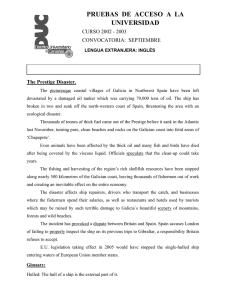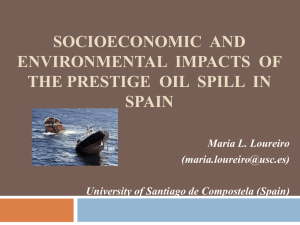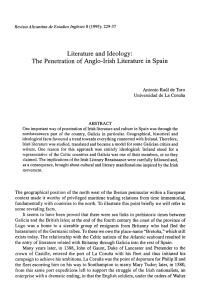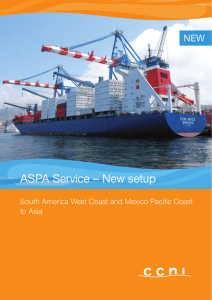Tracking the Prestige oil spill: An operational
Anuncio
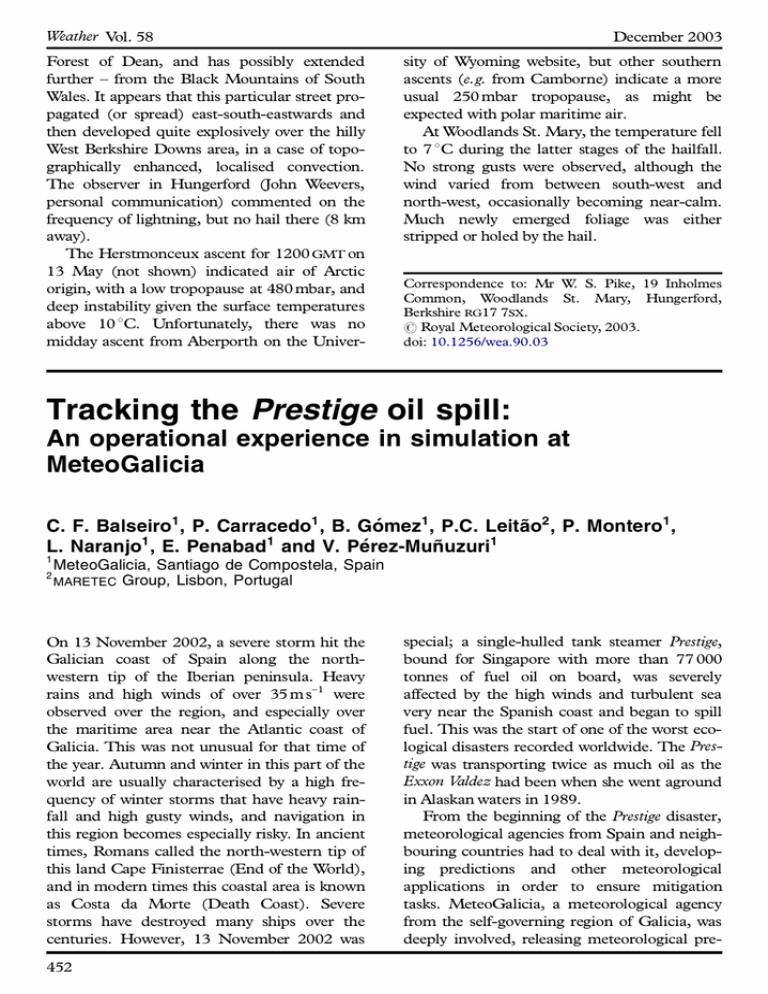
Weather Vol. 58 Forest of Dean, and has possibly extended further ± from the Black Mountains of South Wales. It appears that this particular street propagated (or spread) east-south-eastwards and then developed quite explosively over the hilly West Berkshire Downs area, in a case of topographically enhanced, localised convection. The observer in Hungerford (John Weevers, personal communication) commented on the frequency of lightning, but no hail there (8 km away). The Herstmonceux ascent for 1200 GMT on 13 May (not shown) indicated air of Arctic origin, with a low tropopause at 480 mbar, and deep instability given the surface temperatures above 10 8C. Unfortunately, there was no midday ascent from Aberporth on the Univer- December 2003 sity of Wyoming website, but other southern ascents (e.g. from Camborne) indicate a more usual 250 mbar tropopause, as might be expected with polar maritime air. At Woodlands St. Mary, the temperature fell to 7 8C during the latter stages of the hailfall. No strong gusts were observed, although the wind varied from between south-west and north-west, occasionally becoming near-calm. Much newly emerged foliage was either stripped or holed by the hail. Correspondence to: Mr W. S. Pike, 19 Inholmes Common, Woodlands St. Mary, Hungerford, Berkshire RG17 7SX. # Royal Meteorological Society, 2003. doi: 10.1256/wea.90.03 Tracking the Prestige oil spill: An operational experience in simulation at MeteoGalicia C. F. Balseiro1, P. Carracedo1 , B. Gómez1, P.C. Leitão2 , P. Montero1, L. Naranjo1 , E. Penabad1 and V. Pérez-Muñuzuri1 1 2 MeteoGalicia, Santiago de Compostela, Spain MARETEC Group, Lisbon, Portugal On 13 November 2002, a severe storm hit the Galician coast of Spain along the northwestern tip of the Iberian peninsula. Heavy rains and high winds of over 35 m s± 1 were observed over the region, and especially over the maritime area near the Atlantic coast of Galicia. This was not unusual for that time of the year. Autumn and winter in this part of the world are usually characterised by a high frequency of winter storms that have heavy rainfall and high gusty winds, and navigation in this region becomes especially risky. In ancient times, Romans called the north-western tip of this land Cape Finisterrae (End of the World), and in modern times this coastal area is known as Costa da Morte (Death Coast). Severe storms have destroyed many ships over the centuries. However, 13 November 2002 was 452 special; a single-hulled tank steamer Prestige, bound for Singapore with more than 77 000 tonnes of fuel oil on board, was severely affected by the high winds and turbulent sea very near the Spanish coast and began to spill fuel. This was the start of one of the worst ecological disasters recorded worldwide. The Prestige was transporting twice as much oil as the Exxon Valdez had been when she went aground in Alaskan waters in 1989. From the beginning of the Prestige disaster, meteorological agencies from Spain and neighbouring countries had to deal with it, developing predictions and other meteorological applications in order to ensure mitigation tasks. MeteoGalicia, a meteorological agency from the self-governing region of Galicia, was deeply involved, releasing meteorological pre- Weather Vol. 58 December 2003 Fig. 1 Synoptic chart for 0000 GMT on 13 November 2002 (from the Met Office model) dictions to specific coastal areas and developing an operational ocean± atmosphere coupled modelling system for oil-spill tracking. This paper presents a brief description of the operational oil-spill modelling in MeteoGalicia during the days following the Prestige disaster, assessing its quality and establishing its usefulness for further mitigation efforts. all maximum wind gusts were associated with the afternoon pass of a severe squall line with a `bow echo’ structure as seen in the La CorunÄa radar (not shown) which probably produced unrecorded higher winds, mainly over maritime areas. Synoptic background On 13 November 2002 at 1400 GMT, coincidental with the passage of the severe squall line, the Prestige suffered a leak 55 km away from the Galician coast. Between the 13th and 14th the vessel was practically adrift, approaching to within 7 km of the coast of Cape Fisterra. In anticipation of an eventual risk from severe pollution, the vessel was tugged away from the coast. Then it was moved north-westward until the 15th when it was 110 km from the coast (see Fig. 3). From this point it was carried south-westward towards Portuguese waters, spreading the oil spill into a long `fuel front’ to the west, exposing almost the entire Atlantic coastline of Galicia. On the 19th at 0800 GMT, the vessel collapsed about 260 km west of Cape Silleiro, breaking in two pieces and sinking by 1600 GMT (Fig. 3). The fuel oil spilt from the Prestige during these days can be classified for our purposes as: On 12 November 2002 a deep depression lay to the south-west of Britain, with a deep trough extending to the Iberian peninsula. During the next 24 hours the depression tracked south and became established just west of Ireland, with an active cold front approaching north-west of the Iberian peninsula (Fig. 1). The upper-level flow was south-westerly and quite strong, so this active front crossed Galicia (north-west Spain) during the morning. Moreover, on the 13th a secondary low centre underwent a fast deepening to the west of Galicia moving northeastwards and beating the Galician coast in the afternoon with severe squalls (Fig. 2). The network of meteorological stations belonging to the Galician Government reported gusty south-westerly winds over 28 m s± 1 at Muralla (38 m s± 1), M. da Curra (34 m s± 1 ), CoroÂn (32 m s± 1) and Ferrol (31 m s± 1) (see Fig. 3). Heavy rain of more than 60 mm in 12 hours was recorded in many places in Galicia. Almost The Prestige disaster (i) Initial spilling ± wake of fuel oil during the ship’s track between the initial acci453 Weather Vol. 58 December 2003 Fig. 2 Infrared satellite image for 1200 GMT on 13 November 2002 (from University of Dundee) Fig. 3 Trajectory of the Prestige before the sinking 454 Weather Vol. 58 December 2003 dent on the 13th and the sinking on the 19th. (ii) Main spilling ± fuel oil spilt where the vessel sank. It was considered the most hazardous pollution. An ENVISAT satellite picture taken on the 17th (Fig. 4) shows the initial spilling wake of fuel oil. The coupled model From the day of the Prestige accident, a daily operational prediction of the oil spill’s movement was developed using a coupled model called METEO± MOHID. Daily predictions up to 108 hours in advance were released using the hydrodynamic model MOHID (Coelho et al. 2002; Ruiz-Villarreal et al. 2002) coupled with the Advanced Regional Prediction System (ARPS) meteorological model (Xue et al. 2000; Souto et al. 2003). Fig. 4 ASAR-ENVISAT ESA In order to apply a limited-area oceanographic model to a specific volume, it is necessary to get adequate descriptions of the boundaries. Therefore, much attention has to be paid to the maritime surface to obtain an adequate description of processes in the surface layer of the ocean. The oceanographic model considered was the three-dimensional model called MOHID developed by the Marine and Environmental Technology Research Center (MARETEC) from the Instituto Superior TeÂcnico at the Lisboa Technical University and under Ocean Margin Exchange projects OMEX-I and OMEX-II. Previously, some attempts at a coupled METEO± MOHID model had been made for the Galiciancoast in some case-studies, proving an adequate capacity to simulate the complex behaviour of water currents (Taboada et al. 1998; Montero et al. 1999). MOHID solves the three-dimensional incompressible primitive equations. Hydrostatic equilibrium is assumed as well as the Boussi- satellite image showing the wake of fuel oil, 17 November 2002 455 Weather Vol. 58 nesq approximation (Boussinesq 1903; Gill 1982). Mass and momentum balance equations are solved. The specific mass is calculated as a function of temperature and salinity by a simplified equation of state. The model also solves a transport equation for salinity and temperature. To solve turbulent terms, MOHID is coupled with the General Ocean Turbulence Model (Burchard et al. 1999). The model uses a finite-volume approach to discretize the equations in the horizontal in an Arakawa-C staggered grid (Arakawa and Lamb 1977). A horizontally variable step in the resolution of the equations and a generalised vertical coordinate are allowed. Once the predicted state has been made, a three-dimensional Lagrangian model (GoÂmezGesteira et al. 1999) is applied to obtain the oil-spill track by considering the fuel-oil properties (density, viscosity etc.). In this way, MOHID needs knowledge of the wind field, incoming solar radiation, infrared radiation, and latent and sensible heat fluxes over the ocean surface. These data can be obtained, with the required precision, by considering real-time and predictive output from the Advanced Regional Prediction System (ARPS) (Souto et al. 2003) or other limited-area models (Balseiro et al. 2002). ARPS supplies both analyses and forecasts of mean sea-level surface fields such as wind, temperature and solar radiation for the MOHID spin-up process. Wind-field forecasts up to 108 hours ahead force the upper layer of the MOHID model through the shear stress: ½ wind = » C10jV10jV10 where » is the air density, V10 is the wind at 10 m and C10 is an empirical parameter whose mean value is 1.14 610± 3 (Large and Pond 1981). The factor C10 was fitted for an adequate track of the oil spill. ARPS was developed at the University of Oklahoma and the Center for Analysis and Prediction of Storms. It is a non-hydrostatic atmospheric model and uses a generalised terrain-following coordinate system defined for a compressible atmosphere (Pielke and Martin 1981). ARPS solves prognostic equations for the x, y and z components of the Cartesian velocity, the potential temperature, pressure, 456 December 2003 and the six categories of water substance (water vapour, cloud water, rainwater, cloud ice, snow and hail). The continuous equations are solved numerically using finite-difference methods on an Arakawa-C grid. ARPS is applied to the operational numerical weather forecast for Galicia. The model is run twice a day for 108-hour forecasts using two nested grids. One, with a lower resolution of 50 km and 59 6 51 6 30 grid points, covers western Europe; the other, with a nested higher-resolution grid of 10 km and 43 6 43 6 30 grid points, is centred in the Galicia region. The ARPS model starts from the enhanced 00 h and 12 h forecasts of the National Centers for Environmental Prediction (NCEP) global operational model and uses the boundary conditions also obtained from the NCEP model at a 3 h interval on a coarse grid covering a 3000 km 6 3000 km area. To define the quality of the ARPS performance during these days some simple statistics for the wind-field forecast were developed. For instance, real wind data for some meteorological stations were compared with ARPS predictions for the following 24 hours. Figure 5 shows the predicted wind velocity compared with real values at Corrubedo meteorological station. The performance of the model in simulating the wind direction is shown in Fig. 6 (considering wind intensities higher than 5 m s± 1 ) for the same station. Discussion Two kinds of simulations were developed: one over an `inner field’ to simulate the behaviour of the spill near coastal areas and the other over an `outer field’ to model the behaviour around the sinking area. In both areas mean climatic conditions of temperature and salinity were considered as boundary conditions to initialise the oceanographical module MOHID. Fuel oil spilled during the movement of the vessel between the 13th and 19th (Fig. 3) was adequately described by METEO± MOHID, as can be seen in Fig. 7 (inside front cover) which considers a continuous spilling along the whole track. From the time of the steamer sinking, a daily operational prediction of the main oil spills was developed, giving a day-by-day Weather Vol. 58 December 2003 Fig. 5 Comparison of wind velocity between ARPS 24-hour forecast and measurements from 11 November to 10 December 2002 at Corrubedo ing to note that far from the coast the simulations indicated that the oil spill was mainly driven by the wind over the surface layer of the ocean. Other effects such as the tide and river discharges were incorporated in the model to forecast the oil-spill track near the coast. Conclusions Fig. 6 Scatter plot of wind direction between ARPS 24hour forecast and measurements from 11 November to 10 December 2002 at Corrubedo (considering real wind speed higher than 5 m s± 1 ) update of the spill track. In this way, on 27 November the METEO± MOHID resulting track (shown in Fig. 8, inside front cover) made possible a prediction that indicated the oil spill reaching the coast on the 30th. Observational evidence to test the model performance was provided by the Centre of Marine Environment Monitoring from the Fisheries Department of the Galician Government. These data were composed of aerial and maritime positioning observations of the fuel oil, updated twice a day on the web page http:// www.ccmm-prestige.cesga.es. In Fig. 8 observations of maximum fuel concentration are presented indicating a good agreement with predictions. The highest deviation observed on 25 November was probably due to an underestimation of wind speed from the ARPS prediction. During the first days of the simulations of the main spill, it is interest- On 13 November 2002 a single-hulled tank steamer Prestige, with over 77 000 tonnes of fuel oil on board, was severely affected by high winds and turbulent sea very near the Spanish coast and began to spill fuel, starting one of the worst ecological disasters ever recorded. From the beginning of the Prestige disaster, MeteoGalicia, a meteorological agency of the Galician Government, was deeply involved in developing an operational coupled ocean± atmosphere modelling system for oil-spill tracking called METEO± MOHID. In a general sense, results indicated good agreement between predictions and real-time observations. Results suggest that METEO± MOHID is a useful tool to support mitigation and relief tasks involving marine-pollution hazards, and is very useful for operational oceanography. Acknowledgements Financial support from the Department of Environment of the Galician Government is gratefully acknowledged. The Fisheries Department of the Galician Government provided useful information about monitoring. We would like to thank our colleagues from MeteoGalicia and the MARETEC Group for their support and useful comments. 457 Weather Vol. 58 References Arakawa, A. and Lamb, V. (1977) Computational design of the basic dynamical processes of the UCLA general circulation model. Methods Comput. Phys., 17, pp. 174± 267 Balseiro, C. F., Souto, M. J., Penabad, E., Souto, J. A. and PeÂrez-MunÄuzuri, V. (2002) Development of a limited area model for operational weather forecasting around a power plant: The need for specialized forecasts. J. Appl. Meteorol., 41, pp. 919± 930 Boussinesq, J. (1903) Theorie analytique de la chaleur, Vol. 2. Gauthier-Villars, Paris Burchard, H., Bolding, K. and Ruiz-Villarreal, M. (1999) GOTM, a general ocean turbulence model: Theory, implementation and test cases. European Commission, EUR 18745, see also GOTM website, http://www.gotm.net Coelho, H. S., Neves, R. J. J., White, M., LeitaÄo, P. C. and Santos, A. J. (2002) A model for ocean circulation on the Iberian coast. J. Mar. Syst., 32, pp. 153± 179 Gill, A. E. (1982) Atmosphere± ocean dynamics. Academic Press, New York GoÂmez-Gesteira, M., Montero, P., Prego, R., Taboada, J. J., LeitaÄo, P. C., Ruiz-Villarreal, M., Neves, R. J. J. and PeÂrez-Villar, V. (1999) A twodimensional particle tracking model for pollution dispersion in A CorunÄa and Vigo Rias (NW Spain). Oceanol. Acta, 22, pp. 167± 177 Large, W. G. and Pond, S. (1981) Open ocean momentum flux measurement in moderate to strong winds. J. Phys. Ocean., 11, pp. 324± 336 Montero, P., GoÂmez-Gesteira, M., Taboada, J. J., Ruiz-Villarreal, M., Santos, A. P., Neves, R. J. J., Prego, R. and PeÂrez-Villar, V. (1999) On residual circulation of Vigo Ria using a 3D baroclinic December 2003 model. Bol. Esp. Oceanogr., No. 15. Suplemento-1 Pielke, R. A. and Martin, C. L. (1981) The derivation of a terrain-following coordinate system for use in a hydrostatic model. J. Atmos. Sci., 38, pp. 1707± 1713 Ruiz-Villarreal, M., Montero, P., Taboada, J. J., Prego, R., LeitaÄo, P. C. and PeÂrez-Villar, V. (2002) Hydrodynamic model study of the Ria de Pontevedra under estuarine conditions. Estuarine, Coastal Shelf Sci., 54, pp. 101± 113 Souto, M. J., Balseiro, C. F., PeÂrez-MunÄuzuri, V., Xue, M. and Brewster, K. (2003) Impact of cloud analysis on numerical weather prediction in the Galician region of Spain. J. Appl. Meteorol., 42, pp. 129± 140 Taboada, J. J., Prego, R., Ruiz-Villarreal, M., Montero, P., GoÂmez-Gesteira, M., Santos, A. P. and PeÂrez-Villar, V. (1998) Evaluation of the seasonal variations in the residual patterns in the RõÂ a de Vigo (NW Spain) by means of a 3D baroclinic model. Estuarine, Coastal Shelf Sci., 47, pp. 661± 670 Xue, M., Droegemeier, K. K. and Wong, V. (2000) The Advanced Regional Prediction System (ARPS) ± A multiscale nonhydrostatic atmospheric simulation and prediction tool. Part I: Model dynamics and verification. Meteorol. Atmos. Phys., 75, pp. 161± 193 Correspondence to: Dr V. PeÂrez-MunÄuzuri, MeteoGalicia, ConsellerõÂ a de Medio Ambiente, Xunta de Galicia and Grupo de FõÂ sica No Lineal, Facultad de FõÂ sicas, Universidad de Santiago de Compostela, E15782 Santiago de Compostela, Spain. e-mail: uscfmvpm@cesga.es # Royal Meteorological Society, 2003. doi: 10.1256/wea.51.03 The Shetland polar low of 4 February 2001 D. E. Pedgley Crowmarsh, Oxfordshire Figure 1 is an infrared image for 1612 GMT on 4 February 2001 with a resolution of about 1 km. It shows an organised pattern of convective clouds over the Norwegian Sea, north of Shetland, ranging from the cold, white tops of cumulonimbus clouds, through the grey tops of shallower cumulus clouds, to the dark, 458 relatively warm sea surface. There is a strong impression of a cyclonic circulation centred near 62.58N, 2.58W. This was a polar low, but one with unusual properties. Instead of moving to the south or south-east, as polar lows almost invariably do, it took the opposite direction ± north-west and then west, to the north of
